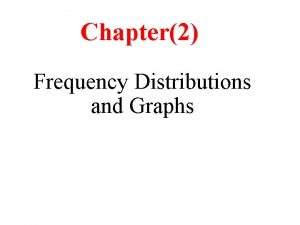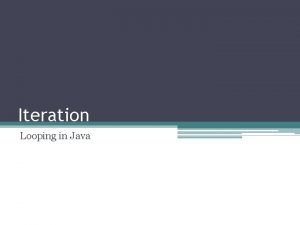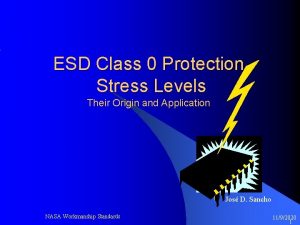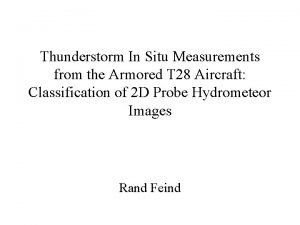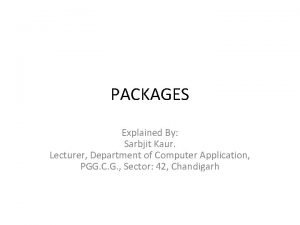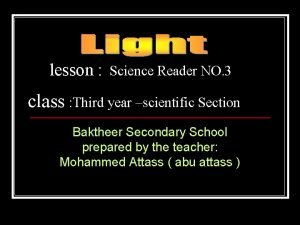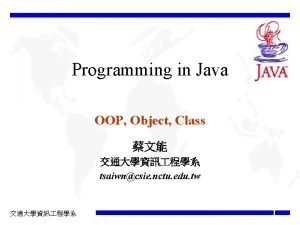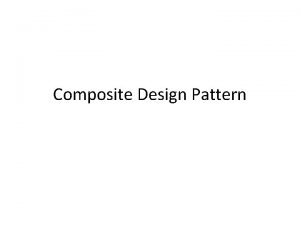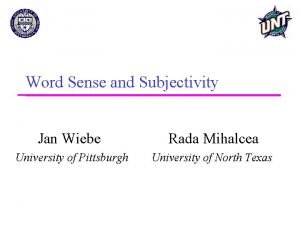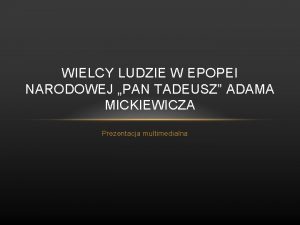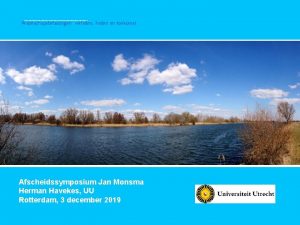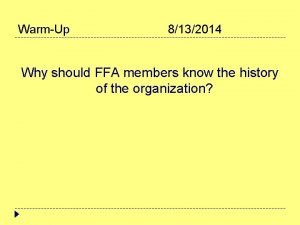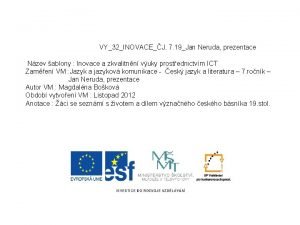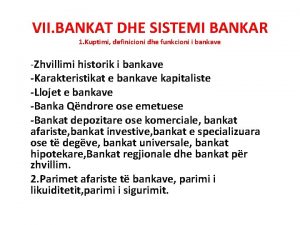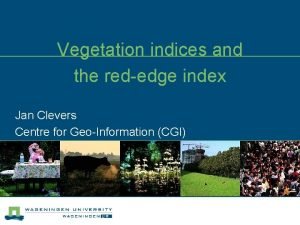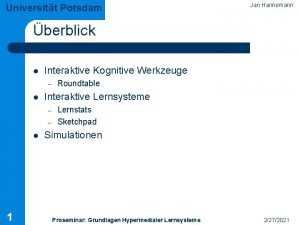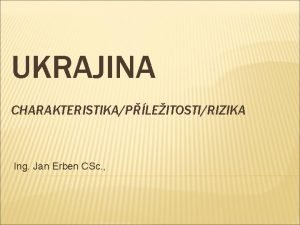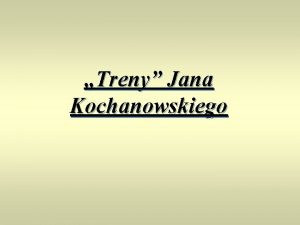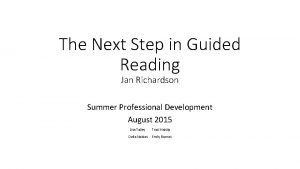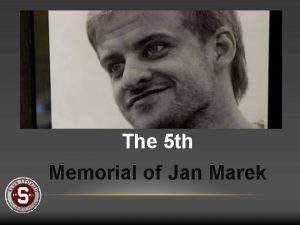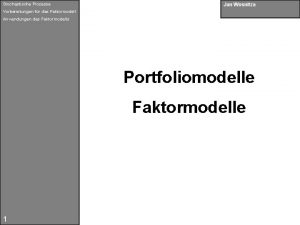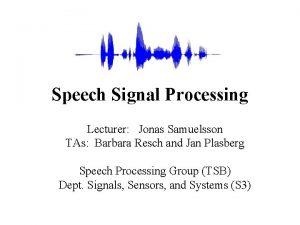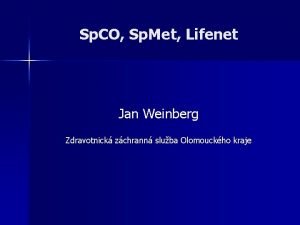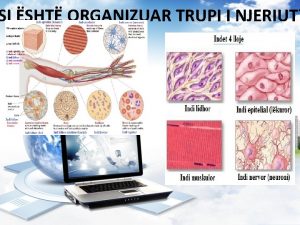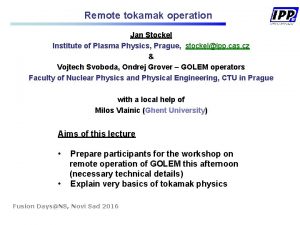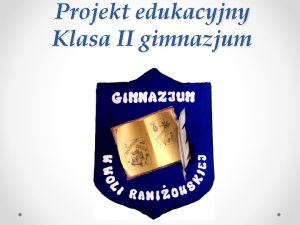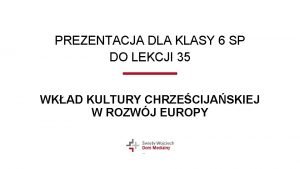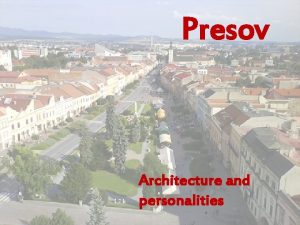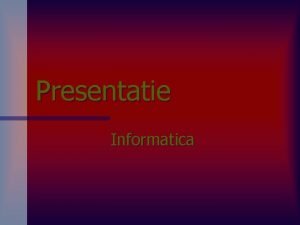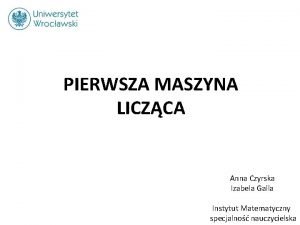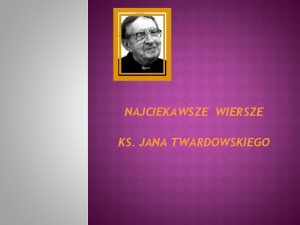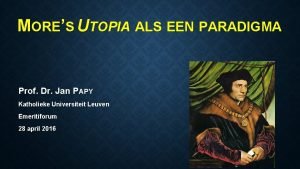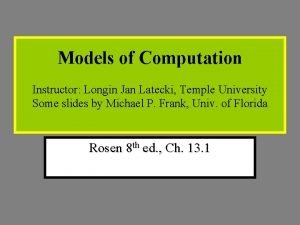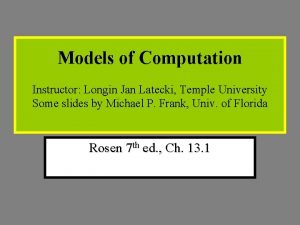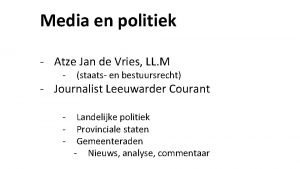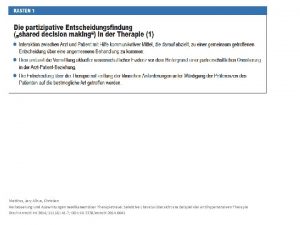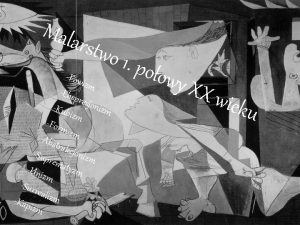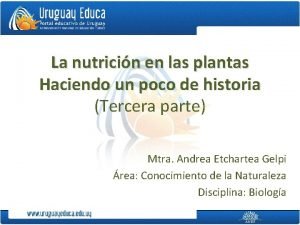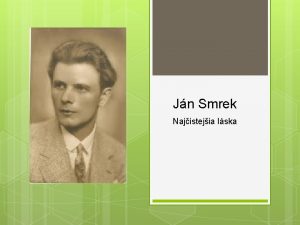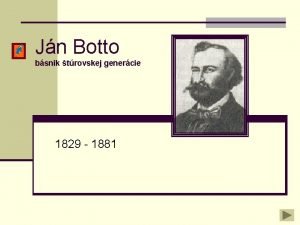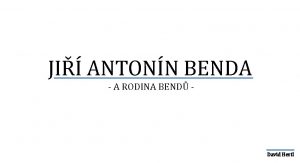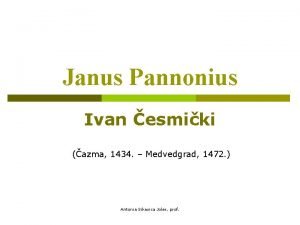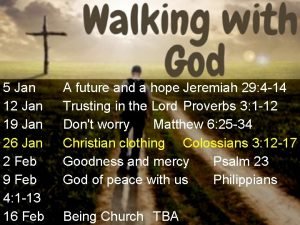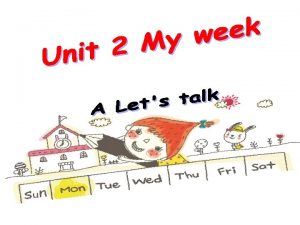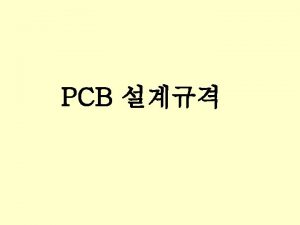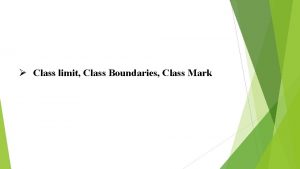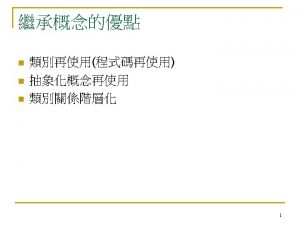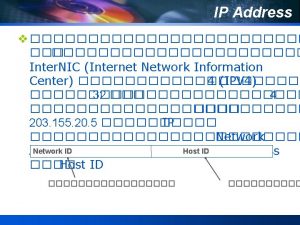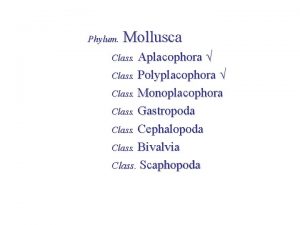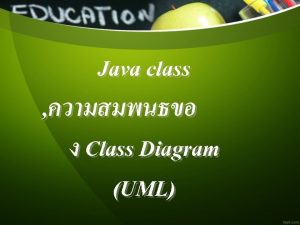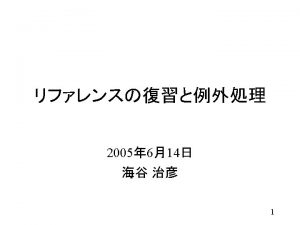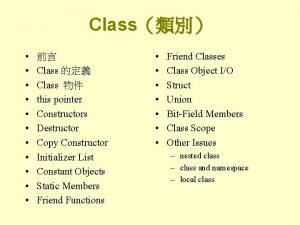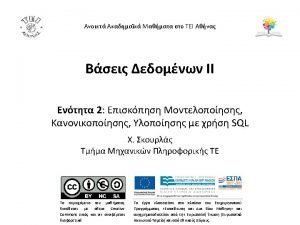Class 5 Jan 21 Ch 3 Histrory of

































































- Slides: 65

Class 5, Jan. 21 Ch 3 (Histrory of Astronomy) “Does the Throne Turn? ” 1. 2. Ancient Roots of Science (Archeoastronomy) Astronomy of Greece: good records & more rational approach a. Thales and Pythagoras: roots of science b. Plato and Aristotle: Geocentric universe c. Ptolemy: mathematical models of geocentric views 3. The Copernican revolution “The Church Strikes back”…at Cersei Copernicus Tycho Kepler Galileo 4. The Nature of Science and Psudoscience Astrology 5. Chapter 4: Making Sense of the Universe

Johannes Kepler • German astronomer and mathematician • Used Tycho’s observations to write 3 laws of planetary motion • He was deeply religious and actually strongly believed in the predictive power of astrology (interesting characters in our soap opera, don’t you think so? )

Kepler’s Laws (on page 64 -65 of book) 1 Each planet’s orbit around the Sun is an ellipse, with the Sun at one focus.

Kepler’s Laws 2 A planet moves along its orbit with a speed that changes in such a way that a line from the planet to the Sun sweeps out equal areas in equal intervals of time. (the closer to the Sun, the faster it moves)

Kepler’s Laws 3 The ratio of the cube of a planet’s average distance from the Sun to the square of its orbital period is the same for each planet. 3 2 a /P = 1 3 a =P a in AU P in years 2

• Kepler first tried to match Tycho’s observations with circular orbits • But an 8 arcminute discrepancy led him eventually to ellipses… Johannes Kepler (1571 -1630) “If I had believed that we could ignore these eight minutes [of arc], I would have patched up my hypothesis accordingly. ” But, since it was not permissible to ignore, those eight minutes pointed the road to a complete reformation in astronomy.

Galileo Galilei (1564 -1642) • First man to point a telescope at the sky • wanted to connect physics on Earth with the heavens • Wrote the book “Dialogue Concerning the Two Chief World Systems”. This book got him in trouble with the Church! Church: Go to your room!

Galileo’s Observations • Galileo discovered that Jupiter had four moons of its own. • Jupiter was the center of its own system. • Heavenly bodies existed which did not orbit the Earth.

Galileo’s observation of the phases of Venus was the final evidence which buried the geocentric model. Geocentric No gibbous or full phases! Heliocentric All phases are seen! Galileo observed all phases!

The Catholic Church ordered Galileo to recant his claim that Earth orbits the Sun in 1633 His book on the subject was removed from the Church’s index of banned books in 1824 Galileo was formally vindicated (pardoned) by the Church in 1992 (ask me if you want to know more juicy details) Galileo Galilei

What have we learned? • How did Copernicus, Tycho and Kepler challenge the Earth-centered idea? • Copernicus created a sun-centered model; Tycho provided the data needed to improve this model; Kepler found a model that fit Tycho’s data. • What was Galileo’s role in the Copernican revolution? • His experiments and observations overcame the remaining objections to the Sun-centered solar system

Ch 3 (Histrory of Astronomy) “Does the World Turn? ” 1. 2. Archeoastronomy Astronomy of Greece: good records & more rational approach a. Thales and Pithagoras: roots of science b. Plato and Aristotle: Geocentric universe c. Ptolemy: mathematical models of geocentric views 3. The Copernican revolution “The Church Strikes back” 4. The Nature of Science 3. 4 The Nature of Science Our goals for learning: How can we distinguish science from nonscience?

Science and Pseudoscience (not exactly like the book) I. Science: 1. 2. 3. II. Based on observations and theory Open to criticism and constant challenge in light of new evidence Not perfect (human), not always right, but is the most successful discipline at predicting the way nature works. Pseudoscience 1. 2. 3. Generally holds “absolute truth” Considers only part of evidence available Tends to play on emotions and fears instead of logic

Hallmarks of Good Science • Science seeks explanations that rely solely on natural causes. • Science progresses by creating and testing models of nature that explain observations as simply as possible: Occam’s Razor • A scientific model must make testable predictions that could force us to revise or abandon the model. • Scientific Theory: a model which survives repeated testing

Astrology (not exactly like book) n n n Ancient Astronomers were also Astrologers (e. g. , Kepler and Galileo) Astrology is not a science Empirical Discipline (no theoretical explanation) Easily abused by charlatans Big problem: astrologers do not agree on what any given celestial configuration means In other words, who will you believe if one astrologer tells you this is a great time to travel and another tells you to stay home?

Chapter 4 Making Sense of the Universe: Understanding Motion, Energy, and Gravity “If I have seen farther than others, it is because I have stood on the shoulders of giants. ” — Sir Isaac Newton (1642 – 1727) © 2005 Pearson Education Inc. , publishing as Addison-Wesley

Outline of Ch 4 Motion and Gravity (soap opera’s final episode) 4. 1 and 4. 2 Describing Motion, Newton and Galileo n. Speed, velocity and acceleration (skip momentum) n. Galileo’s experiments with falling objects: g = 9. 8 m/sec 2 Objects fall together Inertia (motion in absence of force) n. Newton’s Laws: 1. 2. 3 laws of motion: a. Inertia b. F=ma c. Action = Reaction Gravitation: F= GM 1 M 2/d 2 (Inverse-square law) 4. 3 (Thermal Energy only ignore the rest of 4. 3) 4. 4 The force of Gravity n The Strength of Gravity ■ Newton and Kepler n Orbits: 1. Closed: circles (circular velocity) & ellipses (v > vc) 2. Open: parabolas and hyperbolas (escape velocity, v > ve) n Tides: Lunar and Solar © 2005 Pearson Education Inc. , publishing as Addison-Wesley

4. 1 Describing Motion • Our goals for learning: • How do we describe motion? • How is mass different from weight? © 2005 Pearson Education Inc. , publishing as Addison-Wesley

How do we describe motion? Precise definitions to describe motion: • speed: rate at which object moves example: speed of 10 m/s • velocity: speed and direction example: 10 m/s, due east • acceleration: any change in velocity units of speed/time (m/s 2) © 2005 Pearson Education Inc. , publishing as Addison-Wesley

• The Acceleration of Gravity (some not in book) Galileo was one of the giants on who’s shoulders Newton stood. Galileo’s experiments with falling objects showed that: • Objects fall together (not counting friction of air resistance). • On Earth, g ≈ 10 m/s 2: speed increases 10 m/s with each second of falling (g = 9. 8 m/s 2). • Inertia (motion in absence of force: uniform rectilinear or at rest) • g = 9. 8 m/sec 2 • Objects fall together • Inertia (motion in absence of force) © 2005 Pearson Education Inc. , publishing as Addison-Wesley

© 2005 Pearson Education Inc. , publishing as Addison-Wesley

The Acceleration of Gravity (g) • Galileo showed that g is the same for all falling objects, regardless of their mass. Apollo 15 demonstration © 2005 Pearson Education Inc. , publishing as Addison-Wesley

Question: Is there a net force? Y/N 1. 2. 3. 4. A car coming to a stop. A bus speeding up. A bicycle going around a curve. A moon orbiting Jupiter. © 2005 Pearson Education Inc. , publishing as Addison-Wesley

Is there a net force? Y/N 1. 2. 3. 4. A car coming to a stop. Y A bus speeding up. Y A bicycle going around a curve. Y A moon orbiting Jupiter. Y © 2005 Pearson Education Inc. , publishing as Addison-Wesley

How is mass different from weight? • mass – the amount of matter in an object • weight – the force that acts upon an object You are weightless in free-fall! © 2005 Pearson Education Inc. , publishing as Addison-Wesley

Question On the Moon: A. B. C. D. My weight is the same, my mass is less. My weight is less, my mass is the same. My weight is more, my mass is less. © 2005 Pearson Education Inc. , publishing as Addison-Wesley

On the Moon… A. B. C. D. My weight is the same, my mass is less. My weight is less, my mass is the same. My weight is more, my mass is less. © 2005 Pearson Education Inc. , publishing as Addison-Wesley

Why are astronauts weightless in space? • There IS gravity in space… • weightlessness is due to a constant state of free-fall: • Ask me about another way to explain this © 2005 Pearson Education Inc. , publishing as Addison-Wesley

What have we learned? • How do we describe motion? • Speed = distance/time • Speed + direction => velocity (v) • Change in velocity => acceleration (a) © 2005 Pearson Education Inc. , publishing as Addison-Wesley

What have we learned? • How is mass different from weight? • Mass = quantity of matter • Weight = force acting on mass • Objects are weightless when in free-fall © 2005 Pearson Education Inc. , publishing as Addison-Wesley

What have we learned? • Galileo’s experiments with falling objects: • On Earth g = 9. 8 m/sec 2 (m/sec) • Objects fall together • Inertia (motion in absence of force) © 2005 Pearson Education Inc. , publishing as Addison-Wesley

4. 2 Newton’s Laws of Motion Our goals for learning: • How did Newton change our view of the universe? • What are Newton’s three laws of motion? • What is Newton’s laws of gravitation? © 2005 Pearson Education Inc. , publishing as Addison-Wesley

How did Newton change our view of the Universe? • Realized the same physical laws that operate on Earth also operate in the heavens Þ one universe • Discovered 3 laws of motion and law of gravitation • Much more: experiments with light; first reflecting telescope, calculus… Sir Isaac Newton (1642 -1727) © 2005 Pearson Education Inc. , publishing as Addison-Wesley

What are Newton’s three laws of motion? Newton’s first law of motion: An object moves at constant velocity unless a net force acts to change its speed or direction (this he adopted from Galileo). © 2005 Pearson Education Inc. , publishing as Addison-Wesley

Newton’s second law of motion: Force = mass acceleration (F= ma) © 2005 Pearson Education Inc. , publishing as Addison-Wesley

Newton’s third law of motion: For every force, there is always an equal and opposite reaction force (action = reaction). © 2005 Pearson Education Inc. , publishing as Addison-Wesley

The Universal Law of Gravitation 1. Every mass attracts every other mass. 2. Attraction is directly proportional to the product of their masses. 3. Attraction is inversely proportional to the square of the distance between their centers. . © 2005 Pearson Education Inc. , publishing as Addison-Wesley

Question: Is the force the Earth exerts on you larger, smaller, or the same as the force you exert on it? A. Earth exerts a larger force on you. B. I exert a larger force on Earth. C. Earth and I exert equal and opposite forces on each other. D. There is no force between Earth and any object © 2005 Pearson Education Inc. , publishing as Addison-Wesley

Is the force the Earth exerts on you larger, smaller, or the same as the force you exert on it? A. Earth exerts a larger force on you. B. I exert a larger force on Earth. C. Earth and I exert equal and opposite forces on each other. D. There is no force between Earth and any object © 2005 Pearson Education Inc. , publishing as Addison-Wesley

Question: A compact car and a Mack truck have a head-on collision. Are the following true or false? 1. The force of the car on the truck is equal and opposite to the force of the truck on the car. 2. The change of velocity (acceleration) of the car is the same as the change of velocity of the truck. © 2005 Pearson Education Inc. , publishing as Addison-Wesley

Question: A compact car and a Mack truck have a head-on collision. Are the following true or false? 1. The force of the car on the truck is equal and opposite to the force of the truck on the car. T 2. The change of velocity of the car is the same as the change of velocity of the truck. F © 2005 Pearson Education Inc. , publishing as Addison-Wesley

Question: A compact car and a Mack truck have a head-on collision. Are the following true or false? 1. The force of the car on the truck is equal and opposite to the force of the truck on the car. True 2. The change of velocity of the car is the same as the change of velocity of the truck. False (remember F = ma, if “F” is the same and the masses are very different then “a”, which is the change in velocity must also be very different) © 2005 Pearson Education Inc. , publishing as Addison-Wesley

What have we learned? • How did Newton change our view of the universe? • • • He discovered laws of motion & gravitation. He realized these same laws of physics were identical in the universe and on Earth. What are Newton’s Three Laws of Motion? 1) 2) 3) Object moves at constant velocity if no net force is acting. Force = mass acceleration For every force there is an equal and opposite reaction force. © 2005 Pearson Education Inc. , publishing as Addison-Wesley

4. 3 Ignore all except Thermal Energy • Relation temperature motion of atoms : • The higher the temperature the faster the atoms in a substance will be moving • As atoms collide the electrons collide and their motion is disturbed • When the motion of electrons gets disturbed they produce photons • The higher the temperature, the more collisions, the more photons (more about this in Ch. 5) © 2005 Pearson Education Inc. , publishing as Addison-Wesley

End of Ch 4 Motion and Gravity (soap opera’s final episode) 4. 1 and 4. 2 Describing Motion, Newton and Galileo n. Speed, velocity and acceleration (skip momentum) n. Galileo’s experiments with falling objects: g = 9. 8 m/sec 2 Objects fall together Inertia (motion in absence of force) n. Newton’s Laws: 1. 2. 3 laws of motion: a. Inertia b. F=ma c. Action = Reaction Gravitation: F= GM 1 M 2/d 2 (Inverse-square law) 4. 3 (Thermal Energy only) 4. 4 The force of Gravity n n The Strength of Gravity ■ Newton and Kepler Orbits: 1. Closed: circles (circular velocity) & ellipses (v > vc) 2. Open: parabolas and hyperbolas (escape velocity, v > ve) n Tides: Lunar and Solar Chapter 5. Light: the Cosmic Messenger

4. 3 Ignore all except Thermal Energy • Relation temperature motion of atoms : • The higher the temperature the faster the atoms in a substance will be moving • As atoms collide the electrons collide and their motion is disturbed • When the motion of electrons gets disturbed they produce photons • The higher the temperature, the more collisions, the more photons (more about this in Ch. 5) © 2005 Pearson Education Inc. , publishing as Addison-Wesley

Temperature Scales © 2005 Pearson Education Inc. , publishing as Addison-Wesley

Outline of Ch 4 Motion and Gravity (soap opera’s final episode) 4. 1 and 4. 2 Describing Motion, Newton and Galileo n. Speed, velocity and acceleration (skip momentum) n. Galileo’s experiments with falling objects: g = 9. 8 m/sec 2 Objects fall together Inertia (motion in absence of force) n. Newton’s Laws: 1. 2. 3 laws of motion: a. Inertia b. F=ma c. Action = Reaction Gravitation: F= GM 1 M 2/d 2 (Inverse-square law) 4. 3 (Thermal Energy only) 4. 4 The force of Gravity n n The Strength of Gravity ■ Newton and Kepler Orbits: 1. Closed: circles (circular velocity) & ellipses (v > vc) 2. Open: parabolas and hyperbolas (escape velocity, v > ve) n Tides: Lunar and Solar © 2005 Pearson Education Inc. , publishing as Addison-Wesley

4. 4 The Force of Gravity Our goals for learning: • What determines the strength of gravity? • How does Newton’s law of gravity extend Kepler’s laws? • How do gravity and energy together allow us to understand orbits? • How does gravity cause tides? © 2005 Pearson Education Inc. , publishing as Addison-Wesley

What determines the strength of gravity? The Universal Law of Gravitation 1. Every mass attracts every other mass. 2. Attraction is directly proportional to the product of their masses. 3. Attraction is inversely proportional to the square of the distance between their centers. . © 2005 Pearson Education Inc. , publishing as Addison-Wesley

How does Newton’s law of gravity extend Kepler’s laws? (some not in book) • Ellipses are not the only orbital paths. Orbits can be: bound • Circle (v = vc) • Ellipse (v > vc) unbound • Parabola (v = ve) • Hyperbola (v > ve) • Circular and Escape velocities (vc and ve) § vc = GM/R § ve = 2 GM/R © 2005 Pearson Education Inc. , publishing as Addison-Wesley circular and

© 2005 Pearson Education Inc. , publishing as Addison-Wesley

© 2005 Pearson Education Inc. , publishing as Addison-Wesley

• Newton generalized Kepler’s Third Law: Newton’s version of Kepler’s Third Law: If a small object orbits a larger one and you measure the orbiting object’s orbital period AND average orbital distance THEN you can calculate the mass of the larger object. Examples: • Calculate mass of Sun from Earth’s orbital period (1 year) and average distance (1 AU). • Calculate mass of Earth from orbital period and distance of a satellite. • Calculate mass of Jupiter from orbital period and distance of one of its moons. • What about asteroids? © 2005 Pearson Education Inc. , publishing as Addison-Wesley

How do gravity and energy together explain orbits? • Orbits cannot change without energy changing. • An object’s orbit can only change if it somehow gains or loses orbital energy = kinetic energy + gravitational potential energy (due to orbit). Þ So what can make an object gain or lose orbital energy? • Friction or atmospheric drag • Rocket engine • A gravitational encounter. © 2005 Pearson Education Inc. , publishing as Addison-Wesley

• If an object gains enough orbital energy, it may escape (change from a bound to unbound orbit) • escape velocity from Earth ≈ 11 km/s from sea level (about 40, 000 km/hr, 25, 000 mph) • What is Earth’s circular © 2005 Pearsonvelocity Education Inc. , at sea level? publishing as Addison-Wesley

• How does Newton’s law of gravity extend Kepler’s laws? (some not in book) Ellipses are not the only orbital paths. Orbits can be: bound • Circle (v = vc) • Ellipse (v > vc) unbound • Parabola (v = ve) • Hyperbola (v > ve) • Circular and Escape velocities (vc and ve) § vc = GM/R § ve = 2 GM/R © 2005 Pearson Education Inc. , publishing as Addison-Wesley circular and

Mastering Astronomy: Study area: Ch 4 Interactive Fig. 4. 18 © 2005 Pearson Education Inc. , publishing as Addison-Wesley

Escape and orbital velocities do NOT depend on the mass of the cannonball However according to Newton’s second law of motion (F=ma) is it just as easy to put a light or a heavy object into orbit? © 2005 Pearson Education Inc. , publishing as Addison-Wesley

However according to Newton’s second law of motion (F=ma) is it just as easy to put a light or a heavy object into orbit? Less than 1% of the mass of a rocket is the satellite that goes into orbit © 2005 Pearson Education Inc. , publishing as Addison-Wesley

If you want to reach a circular orbit what should be the speed of you cannon ball? © 2005 Pearson Education Inc. , publishing as Addison-Wesley

If you want to escape Earth’s gravity what should be the speed of you cannon ball? What type of orbit will that be? © 2005 Pearson Education Inc. , publishing as Addison-Wesley

Outline of Ch 4 Motion and Gravity (soap opera’s final episode) 4. 1 and 4. 2 Describing Motion, Newton and Galileo n. Speed, velocity and acceleration (skip momentum) n. Galileo’s experiments with falling objects: g = 9. 8 m/sec 2 Objects fall together Inertia (motion in absence of force) n. Newton’s Laws: 1. 2. 3 laws of motion: a. Inertia b. F=ma c. Action = Reaction Gravitation: F= GM 1 M 2/d 2 (Inverse-square law) 4. 3 (Thermal Energy only) 4. 4 The force of Gravity n n The Strength of Gravity ■ Newton and Kepler Orbits: 1. Closed: circles (circular velocity) & ellipses (v > vc) 2. Open: parabolas and hyperbolas (escape velocity, v > ve) n Tides: Lunar and Solar © 2005 Pearson Education Inc. , publishing as Addison-Wesley

Question The tides due to the Moon affect: a) Only the Oceans b) The whole Earth c) Only the night side of Earth d) None of the other answers is correct

Question The tides due to the Moon affect: a) Only the Oceans b) The whole Earth c) Only the night side of Earth d) None of the other answers is correct
 Todaysclass
Todaysclass Package mypackage; class first { /* class body */ }
Package mypackage; class first { /* class body */ } Introduction to ooad
Introduction to ooad Mean median mode grouped data exercises
Mean median mode grouped data exercises Class i vs class ii mhc
Class i vs class ii mhc Abstract concrete class relationship
Abstract concrete class relationship Lower class limit
Lower class limit Stimulus
Stimulus Stimuli vs stimulus
Stimuli vs stimulus 7 rights of medication administration in order
7 rights of medication administration in order Class maths student student1 class student string name
Class maths student student1 class student string name How to find class boundaries
How to find class boundaries In greenfoot, you can cast an actor class to a world class?
In greenfoot, you can cast an actor class to a world class? Static and dynamic class loading in java
Static and dynamic class loading in java Esd class levels
Esd class levels Uml static
Uml static Class 2 class 3
Class 2 class 3 Public class test subject extends test class
Public class test subject extends test class Package mypackage class first class body
Package mypackage class first class body Class third class
Class third class Protected in uml
Protected in uml Component class has composite class as collaborator
Component class has composite class as collaborator Jan wiebe
Jan wiebe Rębajło pan tadeusz
Rębajło pan tadeusz Nuborgh college lambert franckens
Nuborgh college lambert franckens Jan monsma
Jan monsma Jan eberly ffa facts
Jan eberly ffa facts Jan neruda prezentace
Jan neruda prezentace Koncentrim kuptimi
Koncentrim kuptimi Bilal chababi
Bilal chababi Jan clevers
Jan clevers Jan ketelhut
Jan ketelhut Jan hannemann
Jan hannemann Jan erben
Jan erben Jaki jest najkrótszy tren jana kochanowskiego
Jaki jest najkrótszy tren jana kochanowskiego Jan richardson sight words
Jan richardson sight words Jan marek memorial
Jan marek memorial Jan wosnitza
Jan wosnitza Jan plasberg
Jan plasberg Jan weinberg
Jan weinberg Ku gjendet indi epitelial
Ku gjendet indi epitelial Jan stockel
Jan stockel Biskup jan ozga
Biskup jan ozga Symbole chrześcijańskie prezentacja
Symbole chrześcijańskie prezentacja Adam rayman
Adam rayman Jan nonneman
Jan nonneman Anna czyrska
Anna czyrska Funksionet e parase
Funksionet e parase Jan aksentijević
Jan aksentijević Robert jan osse
Robert jan osse Ks. jan twardowski wiersze
Ks. jan twardowski wiersze Prof. dr. jan papy
Prof. dr. jan papy Longin jan latecki
Longin jan latecki Longin jan latecki
Longin jan latecki Atze de vries
Atze de vries Jan albus
Jan albus Kierunek zapoczatkowany przez picassa
Kierunek zapoczatkowany przez picassa Experimento de jan ingenhousz
Experimento de jan ingenhousz Kystvakt jan mayen klassen
Kystvakt jan mayen klassen Podjl
Podjl Najčistejšia láska ján smrek
Najčistejšia láska ján smrek Stojí stojí mohyla na mohyle zlá chvíľa
Stojí stojí mohyla na mohyle zlá chvíľa Basen zlta lalia
Basen zlta lalia Ján adam rayman
Ján adam rayman Jan jiří benda
Jan jiří benda Panegirik prijevod
Panegirik prijevod











